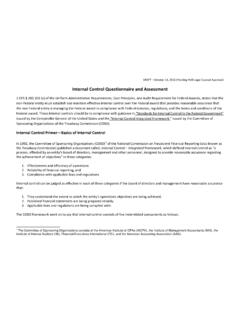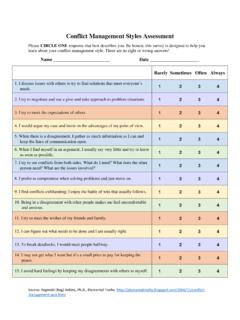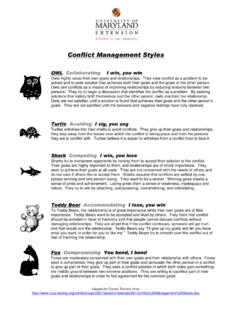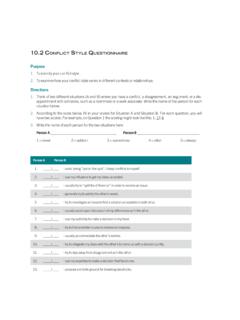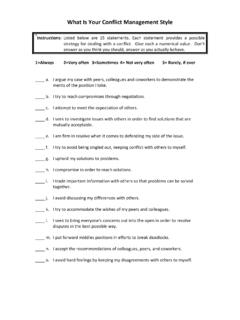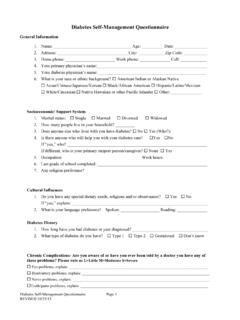Transcription of Leadership Style Questionnaire - NCSU
1 Leadership November 2005 Participant Handout Page 1 of 4 Leadership Style Questionnaire Instructions - Think of a group or organisation in which you are a member. Visualise yourself in charge of a group discussion. As you lead the group, the following six problems arise. Read the first problem and possible solutions. Choose the best of the possible solutions and circle the letter, which matches that solution. Keep in mind that you are in charge of group discussion for a particular group. 1. Your group is having trouble getting started. You have tried to make everyone feel comfortable.
2 You have allowed time to get acquainted. Everyone seems interested and cooperative, but reluctant to speak up. a. Wait until they're ready to speak up. b. Suggest that the group vote on what to do next. c. Make some specific assignments to different people and help them complete their assignments. 2. The group is operating extremely well. Members get along well with each other. Discussion is lively. Everyone is contributing to the group. You want to insure that this continues. a. Reduce your Leadership . Let group members lead the group as much as possible. b. Be sure agreement is reached on each point before proceeding.
3 C. Keep the group firmly under your control or the group will lose its momentum. 3. The group has been very productive. Two or three members have done most of the talking and all of the work. Everyone seems happy, but you would like to make some changes so that more members will get involved. a. Tell it like it is. Outline the changes and see that they are made. b. Propose the changes. Explain why they are needed, then let the group decide what will be done. c. Don't do anything that might threaten group productivity. 4. The group is working well and relations among members are very positive.
4 You feel somewhat unsure about your lack of direction of the group. a. Leave the group alone. b. Slowly assert yourself to give the group more direction. c. Ask the group if you should provide more direction, then comply with their wishes. 5. The group was going great, but now it is falling apart. Members are beginning to bicker. It is hard to stay on the subject. Someone has just suggested that maybe the group should take a recess for two or three months. a. Let everyone have their say. Don't get involved. b. Take a vote on the suggested recess. c. Propose a new course of action for the group.
5 If no one strongly disagrees, make assignments and see that they are carried out. 6. Your group has completed an excellent discussion of a topic they chose, but no one wants to take any action although several activities would be appropriate and each activity has been discussed. a. Suggest that the group move on to another topic. If no one disagrees, list possible topics. b. Choose an activity for the group and make assignments. c. Just keep quiet until the group arrives at a decision. Emergency Field Coordination Training Leadership November 2005 Participant Handout Page 2 of 4 Scoring Your Leadership Style Tendencies Each of the three possible solutions to each problem corresponds to one of the three styles of Leadership : Problem Directive Democratic Non-Directive/Delegative 1 C B A 2 C B A 3 A B C 4 B C A 5 C B A 6 B A C Assessing Your Results and Your Leadership Style Tendencies In problem 1, the group needs direction.
6 Voting would not be useful. A non-directive approach might work in the long run, but would be frustrating in the short term. (c) is the best solution. In problem 2, there is no problem. "If it isn't broke, don't fix it!" (a) is the best solution. In 3, the group is productive, but not everyone is contributing. The group needs help but a directive approach (a) might cause a rebellion. Non-directive (c) Style would not get the quiet members involved. Go with (b). Problem 4 is similar to 2. The group is working well. Resist the temptation to take action when none is needed. Try (a).
7 In problem 5, the group was all right, but now it is not. Leadership is required. Non-directive (a) Leadership will only worsen the situation. If you vote (b), frustration may get in the way of reason. Directive Leadership (c) is the best bet. In 6, democratic Leadership (a) is called for. A directive (b) approach would oppose the group's stated position. Since the group is at a stalemate, solution (c), the non-directive Style , would not help. How to Interpret this Exercise The answers given above suggest the correct Leadership Style given the situation portrayed in each statement. However, if you answered differently, don t worry.
8 You may have interpreted the problems in a different way than was intended. You may not be wrong at all. But if you chose mostly "directive" solutions, or mostly democratic , or mostly emergent , take care: you may need to work harder on developing the other two styles . An effective leader will develop their skills at each Style and learn to use all three styles when necessary. Caution!! The purposes of this exercise are to point out three Leadership styles , to reflect your tendencies in a specific situation, and to highlight the need for practicing situational Leadership .
9 This exercise is not sophisticated enough to categorise your Leadership Style . Please don't look at the results this way. Emergency Field Coordination Training Leadership November 2005 Participant Handout Page 3 of 4 Leadership styles [Background Reading] Introduction & Definition Most leaders think very little about their own Leadership Style . They "do what comes naturally" when Leadership is needed. If they are successful leaders, their instincts usually serve them well. To develop your Leadership ability, however, you need to be more aware of how you lead. A leader is someone who influences others.
10 We all have an image of a leader. It can be described by such words as intelligent, courageous, persuasive, skilful, and powerful. You may have heard the myth that Leaders are Born, Not Made! However, numerous Leadership studies and programs have shown that individuals with a desire to do so, can take steps to learn, practice and improve their Leadership capabilities and develop into leaders. In this course, our working definition for Leadership is the following: Leadership refers to the initiative or ability of a person (or group) to mobilize &/or influence internal and/or external stakeholders to achieve desired results.
